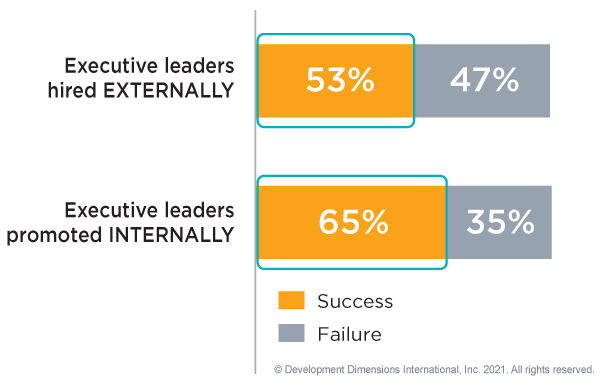It’s the ugly secret of the C-suite: An extraordinarily high rate of executive transitions turn out to be failures.
How high are these rates? According to our recent Leadership Transitions Report 2021, part of our Global Leadership Forecast series, 35% of all executives promoted internally are considered failures.
And that number skyrockets to 47% when the executive is hired from the outside.

Sadly, findings like ours aren’t a new phenomenon. The more important question is why they keep occurring. Why do boards and senior executives accept these dismal rates of success in their highest-impact leadership roles?
One fair assumption is that leadership jobs have never been more difficult than they are in today’s complex, competitive, resource-depleted environment. But another is that new executives simply don’t see it coming. I’ve coached dozens of struggling executives over the years, and almost every time, their failure is a surprise—to themselves, their C-suites, their boards, and their teams.
The story goes like this: They’ve been high performers with track records of strong results, engaged teams, and deft handling of ever-more-challenging assignments. Senior management’s confidence in them swells.
And then they get their first executive role. Director. Vice president. General manager or similar. And it's like a switch flips. The usual cycle of “new challenge–work hard–succeed–move on” is suddenly short-circuited. Performance stalls.
The other consistent part of the story? They almost always keep their struggles private. Executives typically say very little about the issues they’re facing. Having the confidence of senior management to take such a consequential role means (to most) that the obstacles are theirs to figure out.
There’s no crying in baseball or executive leadership.
The Impact of Difficult Executive Transitions
We interview many CHROs about what happens when new executives come in, and we routinely hear things like, “There’s a step back in performance,” or “Progress on the strategy stalls,” and “Turnover suffers on the teams at the level below them.”
Is it too obvious to say that the cost of failed executive transitions is huge? First, there are the costs of replacing the executive if they leave or are fired, which can be 2.5 to up to 10 times their salary.
But the more profound consequences are the indirect costs of failure when the executive stays in the role. When business unit performance drops off, the pain begins to set in. Add in the opportunity cost of actions not taken and the departure of talented team members, and the full cost of failure comes into view.
But let’s not overlook the personal impact encountered by executives in difficult transitions. In our research over the years, about 40 percent of people said becoming an executive wasn’t a positive experience. Furthermore, they said the transition was as or more stressful than other life challenges such as divorce, raising teenagers, and even death in the family.
According to a study by the National Institutes of Health, transition stress causes major health concerns. On average, executives don’t sleep very well. They have low energy and high anxiety. And they ping-pong from one unhealthy meal to the next. The toll of this vicious cycle adds up, resulting in rampant burnout as well as more serious physical and mental health concerns.
The good news is that companies don’t have to sit by idly. There’s a lot the company can do to support successful executive transitions.
The Mistakes Most Companies Make in Executive Transitions
At an HR conference (back when things were still in person), we asked a room of about 40 HR leaders who among them felt they were doing enough to support their executives. Not one hand went up. In fact, the one word most commonly used when asked what is being done to support the success of new executives was, “Nothing.”
It’s not because CHROs and senior management don’t care. We typically hear three main reasons why they don’t do anything for executives:
- Executives should be able to figure it out. Most C-level and other senior executives often didn’t get much (or any) support during their own transitions. Since they were able to overcome the challenges, they figure new executives will do the same if they’re truly talented. But this mentality ignores the increasing degree of difficulty in executive leadership and the steep cost of failure.
- We can’t afford coaches for every executive. Most people are familiar with executive coaching as one of the few options for executive development. Because of the time and investment, they reserve it only for their senior-most leaders. But not all coaching engagements have to be long-term or costly. Short, targeted engagements can help executives get on track early and quickly.
- You can’t train for this. Every executive is in a unique leadership situation, and others often don’t understand the nuances. For the same reason, group training can be too generic to be useful. But with the right adjustments to make learning specific to the situation, group development can be a powerful way to align executives and build relationships between them.
There’s no question these can be major barriers. But businesses simply can’t afford to let them stand in the way.
How to Support Successful Executive Transitions
In the Leadership Transitions Report 2021, we took a look at what companies with more successful executive transitions did differently. Plus, we added some of our own experience into what executives say behind the scenes. As a result, we identified five support factors that were most important. These approaches are not mutually exclusive. Often, a mix of tactics works best, depending on your company’s specific business context and unique learning needs.
1. Assessment: Don’t Let Them Fly Blind
Stepping into an executive role is like being asked to fly a plane, despite never having done it before. You might have ridden on the plane, worked in a support role, and understand how the plane works. But as you sit in the pilot’s seat, you realize you’re suddenly responsible for hundreds of lives on board. A totally different experience.
There’s very real risk in not knowing if you’re capable of it. Simply “faking it until you make it” doesn’t work. Not only may you not have some key skills, but some of your previous instincts may be wrong. At this level, executive leadership skills change radically. You may have to unlearn things that were previously strengths, because they can become liabilities at this level.
That’s why executive assessment and feedback creates so much impact in transitions. New leaders can get their footing much faster by understanding where they need to pull back, where to focus, and where they need to add something new to their leadership repertoire.
2. Coach on the Fly: Be There in the Moment to Help Executives Sort Out Complexity
We’ve observed a paradox in how executives respond to new challenges. They seldom proactively ask for help, but when asked, are quick to say that they wish they had more of it.
So why the hesitation? It’s the unique complexity of each executive’s role. It’s difficult to imagine someone coming in to help if they don’t have the full context, and for executives, that can be a lot. But at DDI, we’ve recently conducted research to identify the most prevalent forces that cause executives to struggle. We’ve found that by structuring high-speed support around the 4 forces of executive pressure, executives can hit the reset button extremely quickly, adjust approaches to hasten success, and avoid common pitfalls.
It turns out that support actually can move at the speed of executive performance. But most executives won’t know how to ask for it. You’ll probably have to offer help.
3. Internal Coaching: “Figuring It Out” Wastes Time and Money
The leaders who make it to the executive ranks are typically very driven and accustomed to success. With these high expectations, they often forget how important it is to coach and be coached.
It’s surprising, as this is a key skill for lower-level managers. So why does it evaporate at the senior level?
Several reasons. One is certainly the time pressure. The second is often cultural. Senior executives may expect newer executives to figure it out for themselves, as they may have had to do.
Another reason is that senior executives often don’t realize how much transitioning executives are struggling. Most new executives struggle privately, worrying that admitting a weakness could cost them their job or credibility. So they say nothing until it may be too late.
As the high failure rate shows, a huge percentage of executives don’t figure it out on their own. It’s critical that senior leaders brush up their own coaching and talent development skills. Otherwise, they may let a tremendous amount of time, money, and talent go to waste.
4. External Coaching: Proactively Avoid the Pitfalls
As leaders struggle through their executive transitions, the number-one thing they ask for is an external executive coach. With an external coach, they may be more honest about their challenges, without fear that it will affect their career path.
Even more importantly, an external coach can help them gain an objective perspective. Often, executives are so focused inward that they believe they are the only ones with these struggles. And they beat themselves up for not being better.
But the reality is that most executives fall into the same common pitfalls. An executive coach who has worked with dozens or hundreds of executives can quickly help the new executive spot the pitfalls ahead. And they can help them develop strategies to navigate these complex challenges.
The warning, however, is that most companies wait too long. We often get calls from companies who are looking to rescue an executive. But sometimes they have fallen so deep into these pitfalls they can’t dig themselves out, no matter what they try. That’s why executive transition coaching, which helps them proactively avoid the pitfalls, is so important.
5. Success Profiles: Mysterious Criteria Serves No One
In our study, one of the most common things we heard from executives with successful transitions was that they knew what success looked like. They knew what they would be judged on and what skill sets they needed.
Companies that paint this picture well build out holistic Success ProfilesSM. Ideally, they do this before the executive steps into the role. That way, they can hire a person who has the closest set of skills, knowledge, competences, and personality attributes.
But even once in the role, it helps executives to see exactly what success looks like in the role. This can help them break away from their old thinking about success. For example, as operational leaders, they may have focused on details of execution, which made them successful in that role. But as they edge toward more strategic roles, these execution skills will likely need to be augmented by long-range planning and change leadership skills. A success profile will create a holistic picture of the type of all-around leader they need to be.
The Success Difference for Internal vs. External Executive Hires
Beyond the basics, one of the key factors in executive transitions is whether it’s an internal or external hire. As I mentioned in the beginning, our recent research found that HR considers 35% of internal executives as failures, compared to a whopping 47% of external executive hires.
Does that mean you should never hire externally? Of course not.
In our experience, external executive candidates tend to perform better when you need to lead uncomfortable change. They may be more likely to question norms, asking “Why are we doing it this way?” And they may bring new insight and experience that can drive innovation.
But there’s no getting around the fact that they have a higher rate of failure. I’ve seen many external executives struggle to understand the full context of the business quickly enough, especially if they’re also new to the industry. They also face the much bigger challenge of building their networks and navigating company politics, which can be extremely tricky.
Meanwhile, internal hires already have a solid base of knowledge and relationships to work from. And you’ve likely been able to observe their behavior for years. However, they may struggle to break the status quo. And they may lack outside perspective that could help them bring a new approach to their team.
One note of caution is that these statistics are based on the perceptions of HR. For them, an internally promoted executive who doesn’t rock the boat may be considered a success, even if they fail to drive better business results, whereas a “mover and shaker” from the outside may be more likely to be perceived as a failure simply because they ruffle more feathers.
In our view, both types still experience high rates of failure. But what’s crucial is getting them the right support early on, tailored to their needs. External hires may need more help with networking and building cultural fit. Meanwhile, internal promotions may need to develop more innovative ways of thinking.
Success isn’t dependent on where they come from. Rather, it’s the support they get in their transition to help them be successful in where they’re going.

It’s not too late!
The one thing that’s clear in this study is that high executive failure rates are rarely because your leaders aren’t smart enough or good enough. It’s very often because they are thrown in too quickly, without enough support. And precisely because they are so talented, many companies don’t get them the support they need until it’s too late.
What’s too late? Well, ideally executives get proactive support before and during their transition. But even people who have been in their roles for a while can still benefit by going back and getting one or more of the four key support factors we mentioned earlier. The trick is not to wait until the business is tanking and the complaints are loud.
After all, these are smart, talented people. But no one has it all. Everyone has an Achilles’ heel. What’s important is helping executives find theirs before it’s too late for them or for their part of the business.
And don’t forget: Not only will you see the benefits in current performance, but these leaders are the bench for your future C-suite. Don’t deny them support until they’re running the company. Step in now while your new executives are in learning mode. The insights and skills they gain today will pay handsomely when they’re responsible for the entire enterprise.
Learn about Executive Leadership Development.
Matt Paese, Ph.D., is Senior Vice President, Succession Management & C-Suite Services at DDI. He leads DDI’s Executive Services group, where he and his team help CEOs, boards, senior teams, and executives enhance leadership to grow business, cultural, and personal success.
Topics covered in this blog

